Molecular Organization and Patterning of the Medulla Oblongata in Health and Disease
Abstract
:1. Introduction
2. Early Developmental Organization
3. Molecular Patterning of the Medulla Oblongata and Neuronal Development
4. The Medulla Oblongata in Health and Disease
Author Contributions
Funding
Institutional Review Board Statement
Informed Consent Statement
Data Availability Statement
Conflicts of Interest
References
- Nieuwenhuys, R. The Structural, Functional, and Molecular Organization of the Brainstem. Front. Neuroanat. 2011, 5, 33. [Google Scholar] [CrossRef]
- VanderHorst, V.G.J.M.; Ulfhake, B. The Organization of the Brainstem and Spinal Cord of the Mouse: Relationships between Monoaminergic, Cholinergic, and Spinal Projection Systems. J. Chem. Neuroanat. 2006, 31, 2–36. [Google Scholar] [CrossRef]
- Nieuwenhuys, R. Principles of Current Vertebrate Neuromorphology. Brain Behav. Evol. 2017, 90, 117–130. [Google Scholar] [CrossRef]
- Hernandez-Miranda, L.R.; Müller, T.; Birchmeier, C. The Dorsal Spinal Cord and Hindbrain: From Developmental Mechanisms to Functional Circuits. Dev. Biol. 2017, 432, 34–42. [Google Scholar] [CrossRef] [PubMed]
- Marín, F.; Aroca, P.; Puelles, L. Hox Gene Colinear Expression in the Avian Medulla Oblongata Is Correlated with Pseudorhombomeric Domains. Dev. Biol. 2008, 323, 230–247. [Google Scholar] [CrossRef] [PubMed]
- Tomás-Roca, L.; Corral-San-Miguel, R.; Aroca, P.; Puelles, L.; Marín, F. Crypto-Rhombomeres of the Mouse Medulla Oblongata, Defined by Molecular and Morphological Features. Brain Struct. Funct. 2016, 221, 815–838. [Google Scholar] [CrossRef] [PubMed]
- Gray, P.A. Transcription Factors Define the Neuroanatomical Organization of the Medullary Reticular Formation. Front. Neuroanat. 2013, 7, 7. [Google Scholar] [CrossRef] [PubMed]
- Koutcherov, Y.; Mai, J.K.; Ashwell, K.W.; Paxinos, G. Organisation of the Human Dorsomedial Hypothalamic Nucleus. Neuroreport 2004, 15, 107–111. [Google Scholar] [CrossRef]
- Hirsch, D.; Kohl, A.; Wang, Y.; Sela-Donenfeld, D. Axonal Projection Patterns of the Dorsal Interneuron Populations in the Embryonic Hindbrain. Front. Neuroanat. 2021, 15, 793161. [Google Scholar] [CrossRef] [PubMed]
- Rice, D.; Barone, S. Critical Periods of Vulnerability for the Developing Nervous System: Evidence from Humans and Animal Models. Environ. Health Perspect. 2000, 108, 511–533. [Google Scholar] [CrossRef]
- Watson, C.; Bartholomaeus, C.; Puelles, L. Time for Radical Changes in Brain Stem Nomenclature—Applying the Lessons From Developmental Gene Patterns. Front. Neuroanat. 2019, 13, 10. [Google Scholar] [CrossRef]
- Di Bonito, M.; Studer, M. Cellular and Molecular Underpinnings of Neuronal Assembly in the Central Auditory System during Mouse Development. Front. Neural Circuits 2017, 11, 18. [Google Scholar] [CrossRef]
- Puelles, L.; Harrison, M.; Paxinos, G.; Watson, C. A Developmental Ontology for the Mammalian Brain Based on the Prosomeric Model. Trends Neurosci. 2013, 36, 570–578. [Google Scholar] [CrossRef]
- Ulloa, F.; Martí, E. Wnt Won the War: Antagonistic Role of Wnt over Shh Controls Dorso-Ventral Patterning of the Vertebrate Neural Tube. Dev. Dyn. 2010, 239, 69–76. [Google Scholar] [CrossRef]
- Chizhikov, V.V.; Iskusnykh, I.Y.; Fattakhov, N.; Fritzsch, B. Lmx1a and Lmx1b Are Redundantly Required for the Development of Multiple Components of the Mammalian Auditory System. Neuroscience 2021, 452, 247–264. [Google Scholar] [CrossRef]
- Elliott, K.L.; Pavlínková, G.; Chizhikov, V.V.; Yamoah, E.N.; Fritzsch, B. Development in the Mammalian Auditory System Depends on Transcription Factors. Int. J. Mol. Sci. 2021, 22, 4189. [Google Scholar] [CrossRef]
- Nieuwenhuys, R.; Puelles, L. Towards a New Neuromorphology; Springer: Berlin/Heidelberg, Germany, 2016; ISBN 978-3-319-25692-4. [Google Scholar]
- Tümpel, S.; Wiedemann, L.M.; Krumlauf, R. Hox Genes and Segmentation of the Vertebrate Hindbrain. Curr. Top. Dev. Biol. 2009, 88, 103–137. [Google Scholar] [CrossRef]
- Cambronero, F.; Puelles, L. Rostrocaudal Nuclear Relationships in the Avian Medulla Oblongata: A Fate Map with Quail Chick Chimeras. J. Comp. Neurol. 2000, 427, 522–545. [Google Scholar] [CrossRef]
- Gray, P.A. Transcription Factors and the Genetic Organization of Brain Stem Respiratory Neurons. J. Appl. Physiol. 2008, 104, 1513–1521. [Google Scholar] [CrossRef]
- Kyriakopoulou, K.; de Diego, I.; Wassef, M.; Karagogeos, D. A Combination of Chain and Neurophilic Migration Involving the Adhesion Molecule TAG-1 in the Caudal Medulla. Development 2002, 129, 287–296. [Google Scholar] [CrossRef]
- De Diego, I.; Kyriakopoulou, K.; Karagogeos, D.; Wassef, M. Multiple Influences on the Migration of Precerebellar Neurons in the Caudal Medulla. Development 2002, 129, 297–306. [Google Scholar] [CrossRef]
- Rodriguez, C.I.; Dymecki, S.M. Origin of the Precerebellar System. Neuron 2000, 27, 475–486. [Google Scholar] [CrossRef]
- Glover, J.C.; Elliott, K.L.; Erives, A.; Chizhikov, V.V.; Fritzsch, B. Wilhelm His’ Lasting Insights into Hindbrain and Cranial Ganglia Development and Evolution. Dev. Biol. 2018, 444, S14–S24. [Google Scholar] [CrossRef]
- Bermingham, N.A.; Hassan, B.A.; Wang, V.Y.; Fernandez, M.; Banfi, S.; Bellen, H.J.; Fritzsch, B.; Zoghbi, H.Y. Proprioceptor Pathway Development Is Dependent on MATH1. Neuron 2001, 30, 411–422. [Google Scholar] [CrossRef]
- Iskusnykh, I.Y.; Steshina, E.Y.; Chizhikov, V.V. Loss of Ptf1a Leads to a Widespread Cell-Fate Misspecification in the Brainstem, Affecting the Development of Somatosensory and Viscerosensory Nuclei. J. Neurosci. 2016, 36, 2691–2710. [Google Scholar] [CrossRef]
- Ray, R.S.; Dymecki, S.M. Rautenlippe Redux—Toward a Unified View of the Precerebellar Rhombic Lip. Curr. Opin. Cell Biol. 2009, 21, 741–747. [Google Scholar] [CrossRef]
- Van der Heijden, M.E.; Zoghbi, H.Y. Loss of Atoh1 from Neurons Regulating Hypoxic and Hypercapnic Chemoresponses Causes Neonatal Respiratory Failure in Mice. eLife 2018, 7, e38455. [Google Scholar] [CrossRef]
- Liu, Z.; Li, H.; Hu, X.; Yu, L.; Liu, H.; Han, R.; Colella, R.; Mower, G.D.; Chen, Y.; Qiu, M. Control of Precerebellar Neuron Development by Olig3 BHLH Transcription Factor. J. Neurosci. 2008, 28, 10124–10133. [Google Scholar] [CrossRef]
- Storm, R.; Cholewa-Waclaw, J.; Reuter, K.; Bröhl, D.; Sieber, M.; Treier, M.; Müller, T.; Birchmeier, C. The BHLH Transcription Factor Olig3 Marks the Dorsal Neuroepithelium of the Hindbrain and Is Essential for the Development of Brainstem Nuclei. Development 2009, 136, 295–305. [Google Scholar] [CrossRef]
- Ben-Arie, N.; McCall, A.E.; Berkman, S.; Eichele, G.; Bellen, H.J.; Zoghbi, H.Y. Evolutionary Conservation of Sequence and Expression of the BHLH Protein Atonal Suggests a Conserved Role in Neurogenesis. Hum. Mol. Genet. 1996, 5, 1207–1216. [Google Scholar] [CrossRef]
- Machold, R.; Klein, C.; Fishell, G. Genes Expressed in Atoh1 Neuronal Lineages Arising from the R1/Isthmus Rhombic Lip. Gene Expr. Patterns 2011, 11, 349–359. [Google Scholar] [CrossRef] [PubMed]
- Landsberg, R.L.; Awatramani, R.B.; Hunter, N.L.; Farago, A.F.; DiPietrantonio, H.J.; Rodriguez, C.I.; Dymecki, S.M. Hindbrain Rhombic Lip Is Comprised of Discrete Progenitor Cell Populations Allocated by Pax6. Neuron 2005, 48, 933–947. [Google Scholar] [CrossRef] [PubMed]
- Strazielle, C.; Dubois, M.; Eyer, J.; Lalonde, R. NFH-LacZ Transgenic Mice: Regional Brain Activity of Cytochrome Oxidase. Exp. Neurol. 2002, 177, 521–530. [Google Scholar] [CrossRef] [PubMed]
- Rose, M.F.; Ahmad, K.A.; Thaller, C.; Zoghbi, H.Y. Excitatory Neurons of the Proprioceptive, Interoceptive, and Arousal Hindbrain Networks Share a Developmental Requirement for Math1. Proc. Natl. Acad. Sci. USA 2009, 106, 22462–22467. [Google Scholar] [CrossRef]
- Yuengert, R.; Hori, K.; Kibodeaux, E.E.; McClellan, J.X.; Morales, J.E.; Huang, T.-W.P.; Neul, J.L.; Lai, H.C. Origin of a Non-Clarke’s Column Division of the Dorsal Spinocerebellar Tract and the Role of Caudal Proprioceptive Neurons in Motor Function. Cell Rep. 2015, 13, 1258–1271. [Google Scholar] [CrossRef]
- Conner, J.M.; Bohannon, A.; Igarashi, M.; Taniguchi, J.; Baltar, N.; Azim, E. Modulation of Tactile Feedback for the Execution of Dexterous Movement. Science 2021, 374, 316–323. [Google Scholar] [CrossRef]
- Yamazaki, K.; Wakasugi, N.; Tomita, T.; Kikuchi, T.; Mukoyama, M.; Ando, K. Gracile Axonal Dystrophy (GAD), a New Neurological Mutant in the Mouse. Proc. Soc. Exp. Biol. Med. 1988, 187, 209–215. [Google Scholar] [CrossRef]
- Edwards, I.J.; Deuchars, S.A.; Deuchars, J. The Intermedius Nucleus of the Medulla: A Potential Site for the Integration of Cervical Information and the Generation of Autonomic Responses. J. Chem. Neuroanat. 2009, 38, 166–175. [Google Scholar] [CrossRef]
- Ausim Azizi, S. …And the Olive Said to the Cerebellum: Organization and Functional Significance of the Olivo-Cerebellar System. Neuroscientist 2007, 13, 616–625. [Google Scholar] [CrossRef]
- Liang, H.; Bácskai, T.; Watson, C.; Paxinos, G. Projections from the Lateral Vestibular Nucleus to the Spinal Cord in the Mouse. Brain Struct. Funct. 2014, 219, 805–815. [Google Scholar] [CrossRef]
- Straka, H.; Vibert, N.; Vidal, P.P.; Moore, L.E.; Dutia, M.B. Intrinsic Membrane Properties of Vertebrate Vestibular Neurons: Function, Development and Plasticity. Prog. Neurobiol. 2005, 76, 349–392. [Google Scholar] [CrossRef]
- Allen Reference Atlases: Atlas Viewer. Available online: https://atlas.brain-map.org/ (accessed on 25 May 2022).
- Pagliardini, S.; Ren, J.; Gray, P.A.; Vandunk, C.; Gross, M.; Goulding, M.; Greer, J.J. Central Respiratory Rhythmogenesis Is Abnormal in Lbx1- Deficient Mice. J. Neurosci. 2008, 28, 11030–11041. [Google Scholar] [CrossRef]
- Pattyn, A.; Guillemot, F.; Brunet, J.-F. Delays in Neuronal Differentiation in Mash1/Ascl1 Mutants. Dev. Biol. 2006, 295, 67–75. [Google Scholar] [CrossRef]
- D’Autréaux, F.; Coppola, E.; Hirsch, M.-R.; Birchmeier, C.; Brunet, J.-F. Homeoprotein Phox2b Commands a Somatic-to-Visceral Switch in Cranial Sensory Pathways. Proc. Natl. Acad. Sci. USA 2011, 108, 20018–20023. [Google Scholar] [CrossRef]
- Gotts, J.; Atkinson, L.; Edwards, I.J.; Yanagawa, Y.; Deuchars, S.A.; Deuchars, J. Co-Expression of GAD67 and Choline Acetyltransferase Reveals a Novel Neuronal Phenotype in the Mouse Medulla Oblongata. Auton. Neurosci. 2015, 193, 22–30. [Google Scholar] [CrossRef]
- Qian, Y.; Fritzsch, B.; Shirasawa, S.; Chen, C.-L.; Choi, Y.; Ma, Q. Formation of Brainstem (nor)Adrenergic Centers and First-Order Relay Visceral Sensory Neurons Is Dependent on Homeodomain Protein Rnx/Tlx3. Genes Dev. 2001, 15, 2533–2545. [Google Scholar] [CrossRef]
- Dauger, S.; Pattyn, A.; Lofaso, F.; Gaultier, C.; Goridis, C.; Gallego, J.; Brunet, J.-F. Phox2b Controls the Development of Peripheral Chemoreceptors and Afferent Visceral Pathways. Development 2003, 130, 6635–6642. [Google Scholar] [CrossRef]
- Shi, M.-Y.; Ding, L.-F.; Guo, Y.-H.; Cheng, Y.-X.; Bi, G.-Q.; Lau, P.-M. Long-Range GABAergic Projections from the Nucleus of the Solitary Tract. Mol. Brain 2021, 14, 38. [Google Scholar] [CrossRef]
- 3d Viewer: Allen Brain Atlas: Mouse Connectivity. Available online: https://connectivity.brain-map.org/3d-viewer (accessed on 25 May 2022).
- Kalia, M.; Fuxe, K.; Goldstein, M. Rat Medulla Oblongata. II. Dopaminergic, Noradrenergic (A1 and A2) and Adrenergic Neurons, Nerve Fibers, and Presumptive Terminal Processes. J. Comp. Neurol. 1985, 233, 308–332. [Google Scholar] [CrossRef]
- Zhang, C.; Hamada, T. Sex Differences in Estrogen Receptor Promoter Expression in the Area Postrema. Neural Regen. Res. 2013, 8, 149–155. [Google Scholar] [CrossRef]
- Matsui, T.; Hongo, Y.; Haizuka, Y.; Kaida, K.; Matsumura, G.; Martin, D.M.; Kobayashi, Y. C-Terminals in the Mouse Branchiomotor Nuclei Originate from the Magnocellular Reticular Formation. Neurosci. Lett. 2013, 548, 137–142. [Google Scholar] [CrossRef]
- Dempsey, B.; Sungeelee, S.; Bokiniec, P.; Chettouh, Z.; Diem, S.; Autran, S.; Harrell, E.R.; Poulet, J.F.A.; Birchmeier, C.; Carey, H.; et al. A Medullary Centre for Lapping in Mice. Nat. Commun. 2021, 12, 6307. [Google Scholar] [CrossRef]
- Revill, A.L.; Vann, N.C.; Akins, V.T.; Kottick, A.; Gray, P.A.; Del Negro, C.A.; Funk, G.D. Dbx1 Precursor Cells Are a Source of Inspiratory XII Premotoneurons. eLife 2015, 4, e12301. [Google Scholar] [CrossRef]
- Kim, E.J.; Battiste, J.; Nakagawa, Y.; Johnson, J.E. Ascl1 (Mash1) Lineage Cells Contribute to Discrete Cell Populations in CNS Architecture. Mol. Cell Neurosci. 2008, 38, 595–606. [Google Scholar] [CrossRef]
- Yamada, M.; Terao, M.; Terashima, T.; Fujiyama, T.; Kawaguchi, Y.; Nabeshima, Y.; Hoshino, M. Origin of Climbing Fiber Neurons and Their Developmental Dependence on Ptf1a. J. Neurosci. 2007, 27, 10924–10934. [Google Scholar] [CrossRef]
- Sieber, M.A.; Storm, R.; Martinez-de-la-Torre, M.; Müller, T.; Wende, H.; Reuter, K.; Vasyutina, E.; Birchmeier, C. Lbx1 Acts as a Selector Gene in the Fate Determination of Somatosensory and Viscerosensory Relay Neurons in the Hindbrain. J. Neurosci. 2007, 27, 4902–4909. [Google Scholar] [CrossRef]
- Jones, S.E.; Stanić, D.; Dutschmann, M. Dorsal and Ventral Aspects of the Most Caudal Medullary Reticular Formation Have Differential Roles in Modulation and Formation of the Respiratory Motor Pattern in Rat. Brain Struct. Funct. 2016, 221, 4353–4368. [Google Scholar] [CrossRef]
- Lu, L.; Cao, Y.; Tokita, K.; Heck, D.H.; Boughter, J.D. Medial Cerebellar Nuclear Projections and Activity Patterns Link Cerebellar Output to Orofacial and Respiratory Behavior. Front. Neural Circuits 2013, 7, 56. [Google Scholar] [CrossRef]
- Manger, P.R.; Eschenko, O. The Mammalian Locus Coeruleus Complex—Consistencies and Variances in Nuclear Organization. Brain Sci. 2021, 11, 1486. [Google Scholar] [CrossRef]
- Schinzel, F.; Seyfer, H.; Ebbers, L.; Nothwang, H.G. The Lbx1 Lineage Differentially Contributes to Inhibitory Cell Types of the Dorsal Cochlear Nucleus, a Cerebellum-like Structure, and the Cerebellum. J. Comp. Neurol. 2021, 529, 3032–3045. [Google Scholar] [CrossRef]
- Balmer, T.S.; Trussell, L.O. Trigeminal Contributions to the Dorsal Cochlear Nucleus in Mouse. Front. Neurosci. 2021, 15, 715954. [Google Scholar] [CrossRef] [PubMed]
- Kakizaki, T.; Sakagami, H.; Sakimura, K.; Yanagawa, Y. A Glycine Transporter 2-Cre Knock-in Mouse Line for Glycinergic Neuron-Specific Gene Manipulation. IBRO Rep. 2017, 3, 9–16. [Google Scholar] [CrossRef] [PubMed]
- Papotto, N.; Reithofer, S.; Baumert, K.; Carr, R.; Möhrlen, F.; Frings, S. Olfactory Stimulation Inhibits Nociceptive Signal Processing at the Input Stage of the Central Trigeminal System. Neuroscience 2021, 479, 35–47. [Google Scholar] [CrossRef] [PubMed]
- Gaufo, G.O.; Wu, S.; Capecchi, M.R. Contribution of Hox Genes to the Diversity of the Hindbrain Sensory System. Development 2004, 131, 1259–1266. [Google Scholar] [CrossRef]
- Farago, A.F.; Awatramani, R.B.; Dymecki, S.M. Assembly of the Brainstem Cochlear Nuclear Complex Is Revealed by Intersectional and Subtractive Genetic Fate Maps. Neuron 2006, 50, 205–218. [Google Scholar] [CrossRef]
- Wang, V.Y.; Rose, M.F.; Zoghbi, H.Y. Math1 Expression Redefines the Rhombic Lip Derivatives and Reveals Novel Lineages within the Brainstem and Cerebellum. Neuron 2005, 48, 31–43. [Google Scholar] [CrossRef]
- Marrs, G.S.; Morgan, W.J.; Howell, D.M.; Spirou, G.A.; Mathers, P.H. Embryonic Origins of the Mouse Superior Olivary Complex. Dev. Neurobiol. 2013, 73, 384–398. [Google Scholar] [CrossRef]
- Cao, X.-J.; Oertel, D. The Magnitudes of Hyperpolarization-Activated and Low-Voltage-Activated Potassium Currents Co-Vary in Neurons of the Ventral Cochlear Nucleus. J. Neurophysiol. 2011, 106, 630–640. [Google Scholar] [CrossRef]
- Dubreuil, V.; Ramanantsoa, N.; Trochet, D.; Vaubourg, V.; Amiel, J.; Gallego, J.; Brunet, J.-F.; Goridis, C. A Human Mutation in Phox2b Causes Lack of CO2 Chemosensitivity, Fatal Central Apnea, and Specific Loss of Parafacial Neurons. Proc. Natl. Acad. Sci. USA 2008, 105, 1067–1072. [Google Scholar] [CrossRef]
- Rose, M.F.; Ren, J.; Ahmad, K.A.; Chao, H.-T.; Klisch, T.J.; Flora, A.; Greer, J.J.; Zoghbi, H.Y. Math1 Is Essential for the Development of Hindbrain Neurons Critical for Perinatal Breathing. Neuron 2009, 64, 341–354. [Google Scholar] [CrossRef]
- Alheid, G.F.; McCrimmon, D.R. The Chemical Neuroanatomy of Breathing. Respir. Physiol. Neurobiol. 2008, 164, 3–11. [Google Scholar] [CrossRef]
- Guyenet, P.G.; Stornetta, R.L.; Abbott, S.B.G.; Depuy, S.D.; Kanbar, R. The Retrotrapezoid Nucleus and Breathing. Adv. Exp. Med. Biol. 2012, 758, 115–122. [Google Scholar] [CrossRef]
- Shi, Y.; Stornetta, R.L.; Stornetta, D.S.; Onengut-Gumuscu, S.; Farber, E.A.; Turner, S.D.; Guyenet, P.G.; Bayliss, D.A. Neuromedin B Expression Defines the Mouse Retrotrapezoid Nucleus. J. Neurosci. 2017, 37, 11744–11757. [Google Scholar] [CrossRef]
- Thoby-Brisson, M.; Karlén, M.; Wu, N.; Charnay, P.; Champagnat, J.; Fortin, G. Genetic Identification of an Embryonic Parafacial Oscillator Coupling to the PreBötzinger Complex. Nat. Neurosci. 2009, 12, 1028–1035. [Google Scholar] [CrossRef]
- Rosin, J.M.; Kurrasch, D.M.; Cobb, J. Shox2 Is Required for the Proper Development of the Facial Motor Nucleus and the Establishment of the Facial Nerves. BMC Neurosci. 2015, 16, 39. [Google Scholar] [CrossRef]
- Abdala, A.P.L.; Liu, B.H.; Rybak, I.A.; Smith, J.C.; Paton, J.F.R. Role of GlyT2 Expressing Neurons in the Bötzinger Complex for Respiratory Rhythm and Pattern Generation. FASEB J. 2010, 24, 614.3. [Google Scholar] [CrossRef]
- Benarroch, E.E. Brainstem Respiratory Control: Substrates of Respiratory Failure of Multiple System Atrophy. Mov. Disord. 2007, 22, 155–161. [Google Scholar] [CrossRef]
- Schnerwitzki, D.; Hayn, C.; Perner, B.; Englert, C. Wt1 Positive DB4 Neurons in the Hindbrain Are Crucial for Respiration. Front. Neurosci. 2020, 14, 529487. [Google Scholar] [CrossRef]
- Wu, J.; Capelli, P.; Bouvier, J.; Goulding, M.; Arber, S.; Fortin, G. A V0 Core Neuronal Circuit for Inspiration. Nat. Commun. 2017, 8, 544. [Google Scholar] [CrossRef]
- Suthakar, K.; Ryugo, D.K. Projections from the Ventral Nucleus of the Lateral Lemniscus to the Cochlea in the Mouse. J. Comp. Neurol. 2021, 529, 2995–3012. [Google Scholar] [CrossRef]
- Bouvier, J.; Caggiano, V.; Leiras, R.; Caldeira, V.; Bellardita, C.; Balueva, K.; Fuchs, A.; Kiehn, O. Descending Command Neurons in the Brainstem That Halt Locomotion. Cell 2015, 163, 1191–1203. [Google Scholar] [CrossRef]
- Bretzner, F.; Brownstone, R.M. Lhx3-Chx10 Reticulospinal Neurons in Locomotor Circuits. J. Neurosci. 2013, 33, 14681–14692. [Google Scholar] [CrossRef]
- Delás, M.J.; Briscoe, J. Chapter Eight—Repressive Interactions in Gene Regulatory Networks: When You Have No Other Choice. In Current Topics in Developmental Biology; Peter, I.S., Ed.; Gene Regulatory Networks; Academic Press: Cambridge, MA, USA, 2020; Volume 139, pp. 239–266. [Google Scholar]
- Hafler, B.P.; Choi, M.Y.; Shivdasani, R.A.; Rowitch, D.H. Expression and Function of Nkx6.3 in Vertebrate Hindbrain. Brain Res. 2008, 1222, 42–50. [Google Scholar] [CrossRef]
- Müller, M.; Jabs, N.; Lork, D.E.; Fritzsch, B.; Sander, M. Nkx6.1 Controls Migration and Axon Pathfinding of Cranial Branchio-Motoneurons. Development 2003, 130, 5815–5826. [Google Scholar] [CrossRef]
- Lemieux, M.; Bretzner, F. Glutamatergic Neurons of the Gigantocellular Reticular Nucleus Shape Locomotor Pattern and Rhythm in the Freely Behaving Mouse. PLOS Biol. 2019, 17, e2003880. [Google Scholar] [CrossRef]
- Genethliou, N.; Panayiotou, E.; Panayi, H.; Orford, M.; Mean, R.; Lapathitis, G.; Malas, S. Spatially Distinct Functions of PAX6 and NKX2.2 during Gliogenesis in the Ventral Spinal Cord. Biochem. Biophys. Res. Commun. 2009, 382, 69–73. [Google Scholar] [CrossRef]
- Pabst, O.; Rummelies, J.; Winter, B.; Arnold, H.-H. Targeted Disruption of the Homeobox Gene Nkx2.9 Reveals a Role in Development of the Spinal Accessory Nerve. Development 2003, 130, 1193–1202. [Google Scholar] [CrossRef] [PubMed]
- Zhou, Q.; Anderson, D.J. The BHLH Transcription Factors OLIG2 and OLIG1 Couple Neuronal and Glial Subtype Specification. Cell 2002, 109, 61–73. [Google Scholar] [CrossRef]
- Yan, X.; Lin, J.; Markus, A.; Rolfs, A.; Luo, J. Regional Expression of ADAM19 during Chicken Embryonic Development. Dev. Growth Differ. 2011, 53, 333–346. [Google Scholar] [CrossRef] [PubMed]
- Guo, H.; Yuan, X.-S.; Zhou, J.-C.; Chen, H.; Li, S.-Q.; Qu, W.-M.; Huang, Z.-L. Whole-Brain Monosynaptic Inputs to Hypoglossal Motor Neurons in Mice. Neurosci. Bull. 2020, 36, 585–597. [Google Scholar] [CrossRef] [PubMed]
- Littlejohn, E.L.; Espinoza, L.; Lopez, M.M.; Smith, B.N.; Boychuk, C.R. GABAA Receptor Currents in the Dorsal Motor Nucleus of the Vagus in Females: Influence of Ovarian Cycle and 5α-Reductase Inhibition. J. Neurophysiol. 2019, 122, 2130–2141. [Google Scholar] [CrossRef]
- Dergacheva, O.; Griffioen, K.J.; Neff, R.A.; Mendelowitz, D. Respiratory Modulation of Premotor Cardiac Vagal Neurons in the Brainstem. Respir. Physiol. Neurobiol. 2010, 174, 102–110. [Google Scholar] [CrossRef]
- Hornung, J.-P. The Human Raphe Nuclei and the Serotonergic System. J. Chem. Neuroanat. 2003, 26, 331–343. [Google Scholar] [CrossRef]
- Ren, J.; Isakova, A.; Friedmann, D.; Zeng, J.; Grutzner, S.M.; Pun, A.; Zhao, G.Q.; Kolluru, S.S.; Wang, R.; Lin, R.; et al. Single-Cell Transcriptomes and Whole-Brain Projections of Serotonin Neurons in the Mouse Dorsal and Median Raphe Nuclei. eLife 2019, 8, e49424. [Google Scholar] [CrossRef]
- Kiyasova, V.; Gaspar, P. Development of Raphe Serotonin Neurons from Specification to Guidance. Eur. J. Neurosci. 2011, 34, 1553–1562. [Google Scholar] [CrossRef]
- Van de Wiel, J.; Meigh, L.; Bhandare, A.; Cook, J.; Nijjar, S.; Huckstepp, R.; Dale, N. Connexin26 Mediates CO2-Dependent Regulation of Breathing via Glial Cells of the Medulla Oblongata. Commun. Biol. 2020, 3, 521. [Google Scholar] [CrossRef]
- Suwabe, T.; Bradley, R.M. Effects of 5-Hydroxytryptamine and Substance P on Neurons of the Inferior Salivatory Nucleus. J. Neurophysiol. 2007, 97, 2605–2611. [Google Scholar] [CrossRef]
- Clément, O.; Valencia Garcia, S.; Libourel, P.-A.; Arthaud, S.; Fort, P.; Luppi, P.-H. The Inhibition of the Dorsal Paragigantocellular Reticular Nucleus Induces Waking and the Activation of All Adrenergic and Noradrenergic Neurons: A Combined Pharmacological and Functional Neuroanatomical Study. PLoS ONE 2014, 9, e96851. [Google Scholar] [CrossRef]
- Dergacheva, O.; Philbin, K.; Bateman, R.; Mendelowitz, D. Hypocretin-1 (Orexin A) Prevents the Effects of Hypoxia/Hypercapnia and Enhances the GABAergic Pathway from the Lateral Paragigantocellular Nucleus to Cardiac Vagal Neurons in the Nucleus Ambiguus. Neuroscience 2011, 175, 18–23. [Google Scholar] [CrossRef]
- Eggers, C.; Fink, G.R.; Möller-Hartmann, W.; Nowak, D.A. Correlation of Anatomy and Function in Medulla Oblongata Infarction. Eur. J. Neurol. 2009, 16, 201–204. [Google Scholar] [CrossRef]
- Amiel, J.; Laudier, B.; Attié-Bitach, T.; Trang, H.; de Pontual, L.; Gener, B.; Trochet, D.; Etchevers, H.; Ray, P.; Simonneau, M.; et al. Polyalanine Expansion and Frameshift Mutations of the Paired-like Homeobox Gene PHOX2B in Congenital Central Hypoventilation Syndrome. Nat. Genet. 2003, 33, 459–461. [Google Scholar] [CrossRef] [PubMed]
- Berry-Kravis, E.M.; Zhou, L.; Rand, C.M.; Weese-Mayer, D.E. Congenital Central Hypoventilation Syndrome. Am. J. Respir. Crit. Care Med. 2006, 174, 1139–1144. [Google Scholar] [CrossRef] [PubMed]
- De Pontual, L.; Népote, V.; Attié-Bitach, T.; Al Halabiah, H.; Trang, H.; Elghouzzi, V.; Levacher, B.; Benihoud, K.; Augé, J.; Faure, C.; et al. Noradrenergic Neuronal Development Is Impaired by Mutation of the Proneural HASH-1 Gene in Congenital Central Hypoventilation Syndrome (Ondine’s Curse). Hum. Mol. Genet. 2003, 12, 3173–3180. [Google Scholar] [CrossRef] [PubMed]
- Shirasawa, S.; Arata, A.; Onimaru, H.; Roth, K.A.; Brown, G.A.; Horning, S.; Arata, S.; Okumura, K.; Sasazuki, T.; Korsmeyer, S.J. Rnx Deficiency Results in Congenital Central Hypoventilation. Nat. Genet 2000, 24, 287–290. [Google Scholar] [CrossRef]
- Rhee, J.W.; Arata, A.; Selleri, L.; Jacobs, Y.; Arata, S.; Onimaru, H.; Cleary, M.L. Pbx3 Deficiency Results in Central Hypoventilation. Am. J. Pathol. 2004, 165, 1343–1350. [Google Scholar] [CrossRef]
- Weese-Mayer, D.E.; Shannon, D.C.; Keens, T.G.; Silvestri, J.M. Idiopathic Congenital Central Hypoventilation Syndrome. Am. J. Respir. Crit. Care Med. 1999, 160, 368–373. [Google Scholar] [CrossRef]
- Fu, C.; Xue, J.; Wang, R.; Chen, J.; Ma, L.; Liu, Y.; Wang, X.; Guo, F.; Zhang, Y.; Zhang, X.; et al. Chemosensitive Phox2b-Expressing Neurons Are Crucial for Hypercapnic Ventilatory Response in the Nucleus Tractus Solitarius. J. Physiol. 2017, 595, 4973–4989. [Google Scholar] [CrossRef]
- Nieminen, P.; Kotilainen, J.; Aalto, Y.; Knuutila, S.; Pirinen, S.; Thesleff, I. MSX1 Gene Is Deleted in Wolf-Hirschhorn Syndrome Patients with Oligodontia. J. Dent. Res. 2003, 82, 1013–1017. [Google Scholar] [CrossRef]
- Battaglia, A.; Carey, J.C.; South, S.T. Wolf–Hirschhorn Syndrome: A Review and Update. Am. J. Med. Genet. Part C Semin. Med. Genet. 2015, 169, 216–223. [Google Scholar] [CrossRef]
- Nesbit, M.A.; Bowl, M.R.; Harding, B.; Ali, A.; Ayala, A.; Crowe, C.; Dobbie, A.; Hampson, G.; Holdaway, I.; Levine, M.A.; et al. Characterization of GATA3 Mutations in the Hypoparathyroidism, Deafness, and Renal Dysplasia (HDR) Syndrome. J. Biol. Chem. 2004, 279, 22624–22634. [Google Scholar] [CrossRef]
- Barakat, A.J.; Raygada, M.; Rennert, O.M. Barakat Syndrome Revisited. Am. J. Med. Genet. Part A 2018, 176, 1341–1348. [Google Scholar] [CrossRef] [PubMed]
- Duncan, J.S.; Fritzsch, B. Continued Expression of GATA3 Is Necessary for Cochlear Neurosensory Development. PLoS ONE 2013, 8, e62046. [Google Scholar] [CrossRef] [PubMed]
- Karis, A.; Pata, I.; van Doorninck, J.H.; Grosveld, F.; de Zeeuw, C.I.; de Caprona, D.; Fritzsch, B. Transcription Factor GATA-3 Alters Pathway Selection of Olivocochlear Neurons and Affects Morphogenesis of the Ear. J. Comp. Neurol. 2001, 429, 615–630. [Google Scholar] [CrossRef]
- Van der Wees, J.; van Looij, M.A.J.; de Ruiter, M.M.; Elias, H.; van der Burg, H.; Liem, S.-S.; Kurek, D.; Engel, J.D.; Karis, A.; van Zanten, B.G.A.; et al. Hearing Loss Following Gata3 Haploinsufficiency Is Caused by Cochlear Disorder. Neurobiol. Dis. 2004, 16, 169–178. [Google Scholar] [CrossRef]
- Pandolfi, P.P.; Roth, M.E.; Karis, A.; Leonard, M.W.; Dzierzak, E.; Grosveld, F.G.; Engel, J.D.; Lindenbaum, M.H. Targeted Disruption of the GATA3 Gene Causes Severe Abnormalities in the Nervous System and in Fetal Liver Haematopoiesis. Nat. Genet 1995, 11, 40–44. [Google Scholar] [CrossRef]
- Gilbertson, M.; Richardson, C.; Eastwood, P.; Wilson, A.; Jacoby, P.; Leonard, H.; Downs, J. Determinants of Sleep Problems in Children with Intellectual Disability. J. Sleep Res. 2021, 30, e13361. [Google Scholar] [CrossRef]
- Dura, E.; Villard, L.; Roux, J.-C. Expression of Methyl CpG Binding Protein 2 (Mecp2) during the Postnatal Development of the Mouse Brainstem. Brain Res. 2008, 1236, 176–184. [Google Scholar] [CrossRef]
- Amaddeo, A.; De Sanctis, L.; Arroyo, J.O.; Khirani, S.; Bahi-Buisson, N.; Fauroux, B. Polysomnographic Findings in Rett Syndrome. Eur. J. Paediatr. Neurol. 2019, 23, 214–221. [Google Scholar] [CrossRef]
- Julu, P.O.; Engerström, I.W.; Hansen, S.; Apartopoulos, F.; Engerström, B.; Pini, G.; Delamont, R.S.; Smeets, E.E. Cardiorespiratory Challenges in Rett’s Syndrome. Lancet 2008, 371, 1981–1983. [Google Scholar] [CrossRef]
- Kron, M.; Zimmermann, J.L.; Dutschmann, M.; Funke, F.; Müller, M. Altered Responses of MeCP2-Deficient Mouse Brain Stem to Severe Hypoxia. J. Neurophysiol. 2011, 105, 3067–3079. [Google Scholar] [CrossRef]
- Zanella, S.; Mebarek, S.; Lajard, A.-M.; Picard, N.; Dutschmann, M.; Hilaire, G. Oral Treatment with Desipramine Improves Breathing and Life Span in Rett Syndrome Mouse Model. Respir. Physiol. Neurobiol. 2008, 160, 116–121. [Google Scholar] [CrossRef]
- Cobolli Gigli, C.; Scaramuzza, L.; De Simone, M.; Rossi, R.L.; Pozzi, D.; Pagani, M.; Landsberger, N.; Bedogni, F. Lack of Methyl-CpG Binding Protein 2 (MeCP2) Affects Cell Fate Refinement During Embryonic Cortical Development. Cereb. Cortex 2018, 28, 1846–1856. [Google Scholar] [CrossRef]
- Li, H.; Zhong, X.; Chau, K.F.; Santistevan, N.J.; Guo, W.; Kong, G.; Li, X.; Kadakia, M.; Masliah, J.; Chi, J.; et al. Cell Cycle-Linked MeCP2 Phosphorylation Modulates Adult Neurogenesis Involving the Notch Signaling Pathway. Nat. Commun. 2014, 5, 5601. [Google Scholar] [CrossRef]
- Gao, H.; Bu, Y.; Wu, Q.; Wang, X.; Chang, N.; Lei, L.; Chen, S.; Liu, D.; Zhu, X.; Hu, K.; et al. Mecp2 Regulates Neural Cell Differentiation by Suppressing the Id1 to Her2 Axis in Zebrafish. J. Cell Sci. 2015, 128, 2340–2350. [Google Scholar] [CrossRef]
- Gulmez Karaca, K.; Brito, D.V.C.; Oliveira, A.M.M. MeCP2: A Critical Regulator of Chromatin in Neurodevelopment and Adult Brain Function. Int. J. Mol. Sci. 2019, 20, 4577. [Google Scholar] [CrossRef]
- Naime, S.; Weiss, M.; Lew, J.; Aziz, J.; Pan, Q.; Allen, M.; Xuchen, X.; Weinstock, J.; Nino, G. Central Breathing Abnormalities in Children with Trisomy 21: Effect of Age, Sex, and Concomitant OSA. Pediatric Pulmonol. 2021, 56, 472–478. [Google Scholar] [CrossRef]
- Siriwardhana, L.S.; Nixon, G.M.; Davey, M.J.; Mann, D.L.; Landry, S.A.; Edwards, B.A.; Horne, R.S.C. Children with down Syndrome and Sleep Disordered Breathing Display Impairments in Ventilatory Control. Sleep Med. 2021, 77, 161–169. [Google Scholar] [CrossRef]
- Fujii, Y.; Aida, N.; Niwa, T.; Enokizono, M.; Nozawa, K.; Inoue, T. A Small Pons as a Characteristic Finding in Down Syndrome: A Quantitative MRI Study. Brain Dev. 2017, 39, 298–305. [Google Scholar] [CrossRef] [PubMed]
- Barlow, G.M.; Lyons, G.E.; Richardson, J.A.; Sarnat, H.B.; Korenberg, J.R. DSCAM: An Endogenous Promoter Drives Expression in the Developing CNS and Neural Crest. Biochem. Biophys. Res. Commun. 2002, 299, 1–6. [Google Scholar] [CrossRef]
- Zollino, M.; Zweier, C.; Van Balkom, I.D.; Sweetser, D.A.; Alaimo, J.; Bijlsma, E.K.; Cody, J.; Elsea, S.H.; Giurgea, I.; Macchiaiolo, M.; et al. Diagnosis and Management in Pitt-Hopkins Syndrome: First International Consensus Statement. Clin. Genet. 2019, 95, 462–478. [Google Scholar] [CrossRef] [PubMed]
- Brockschmidt, A.; Todt, U.; Ryu, S.; Hoischen, A.; Landwehr, C.; Birnbaum, S.; Frenck, W.; Radlwimmer, B.; Lichter, P.; Engels, H.; et al. Severe Mental Retardation with Breathing Abnormalities (Pitt-Hopkins Syndrome) Is Caused by Haploinsufficiency of the Neuronal BHLH Transcription Factor TCF4. Hum. Mol. Genet. 2007, 16, 1488–1494. [Google Scholar] [CrossRef] [PubMed]
- Cleary, C.M.; James, S.; Maher, B.J.; Mulkey, D.K. Disordered Breathing in a Pitt-Hopkins Syndrome Model Involves Phox2b-Expressing Parafacial Neurons and Aberrant Nav1.8 Expression. Nat. Commun. 2021, 12, 5962. [Google Scholar] [CrossRef] [PubMed]
- Li, H.; Zhu, Y.; Morozov, Y.M.; Chen, X.; Page, S.C.; Rannals, M.D.; Maher, B.J.; Rakic, P. Disruption of TCF4 Regulatory Networks Leads to Abnormal Cortical Development and Mental Disabilities. Mol. Psychiatry 2019, 24, 1235–1246. [Google Scholar] [CrossRef] [PubMed]
- Mesman, S.; Bakker, R.; Smidt, M.P. Tcf4 Is Required for Correct Brain Development during Embryogenesis. Mol. Cell. Neurosci. 2020, 106, 103502. [Google Scholar] [CrossRef]
- Ekins, S.; Puhl, A.C.; Davidow, A. Repurposing the Dihydropyridine Calcium Channel Inhibitor Nicardipine as a Nav1.8 Inhibitor In Vivo for Pitt Hopkins Syndrome. Pharm. Res. 2020, 37, 127. [Google Scholar] [CrossRef]
- Flora, A.; Garcia, J.J.; Thaller, C.; Zoghbi, H.Y. The E-Protein Tcf4 Interacts with Math1 to Regulate Differentiation of a Specific Subset of Neuronal Progenitors. Proc. Natl. Acad. Sci. USA 2007, 104, 15382–15387. [Google Scholar] [CrossRef]
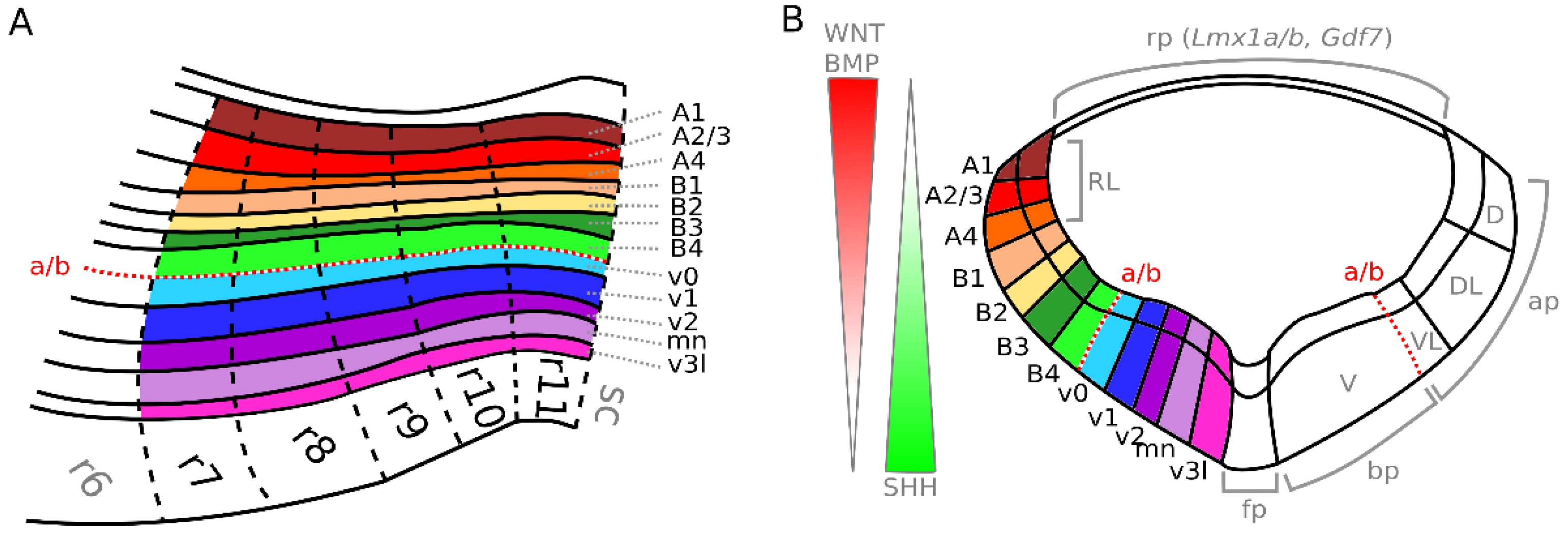
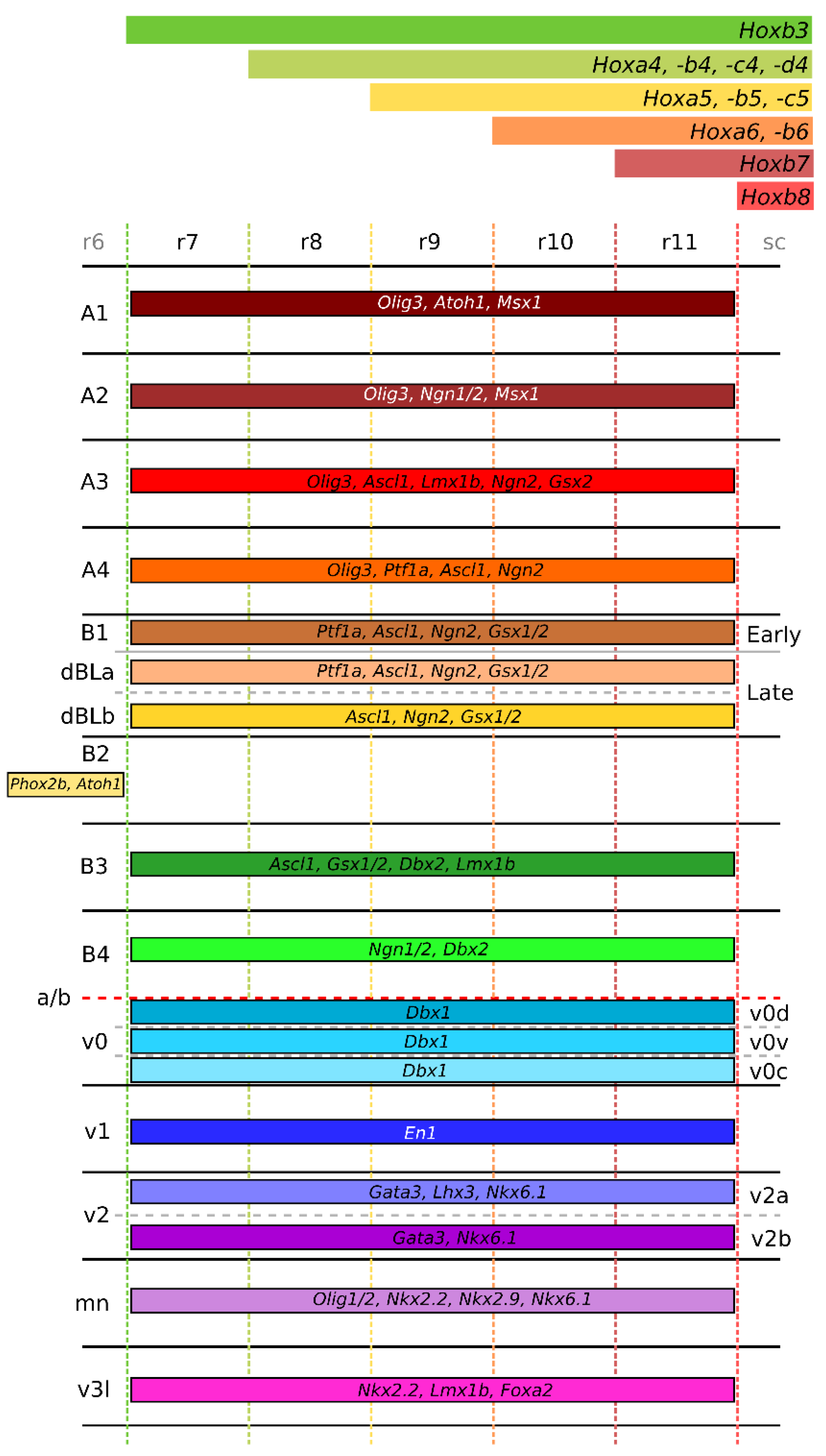
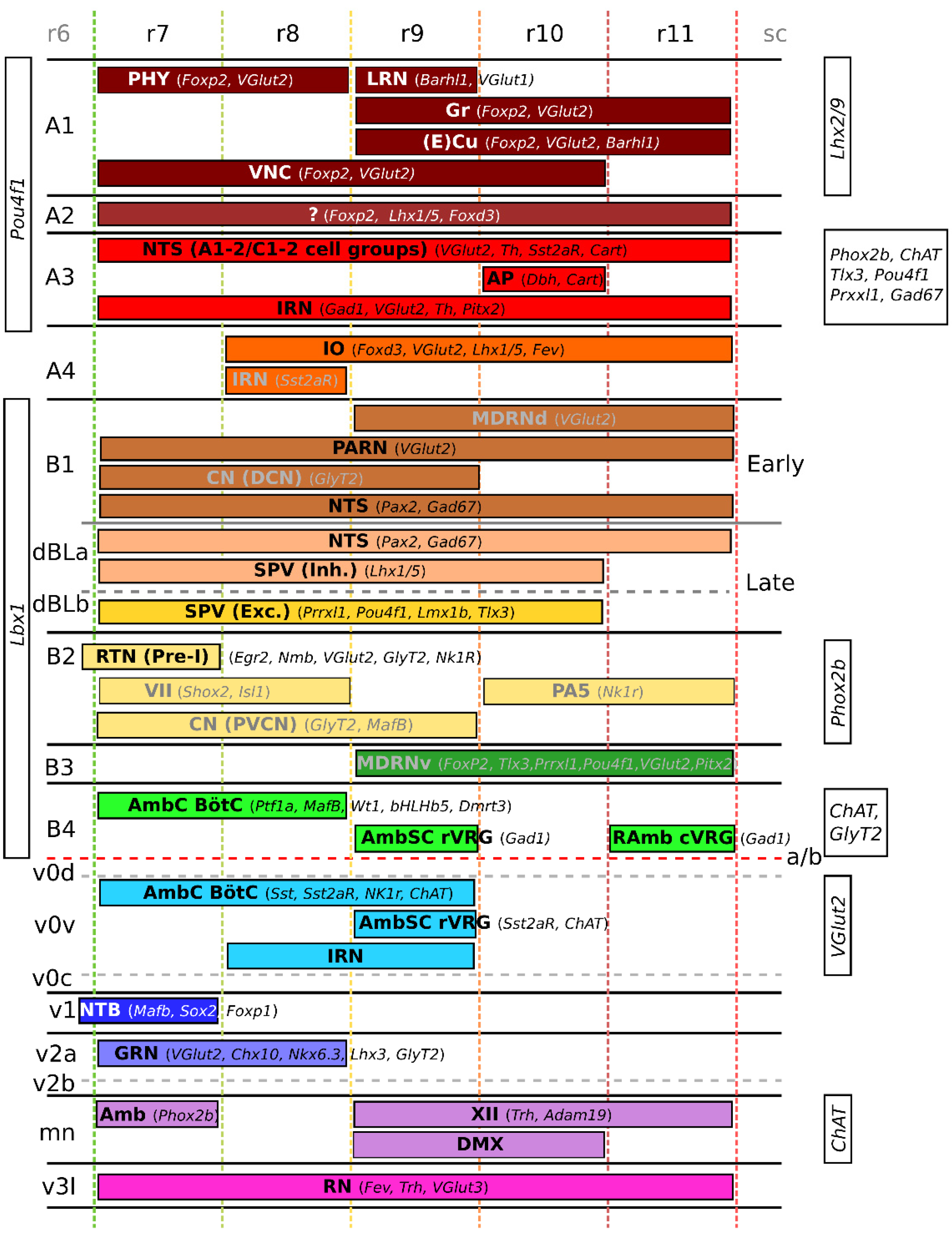
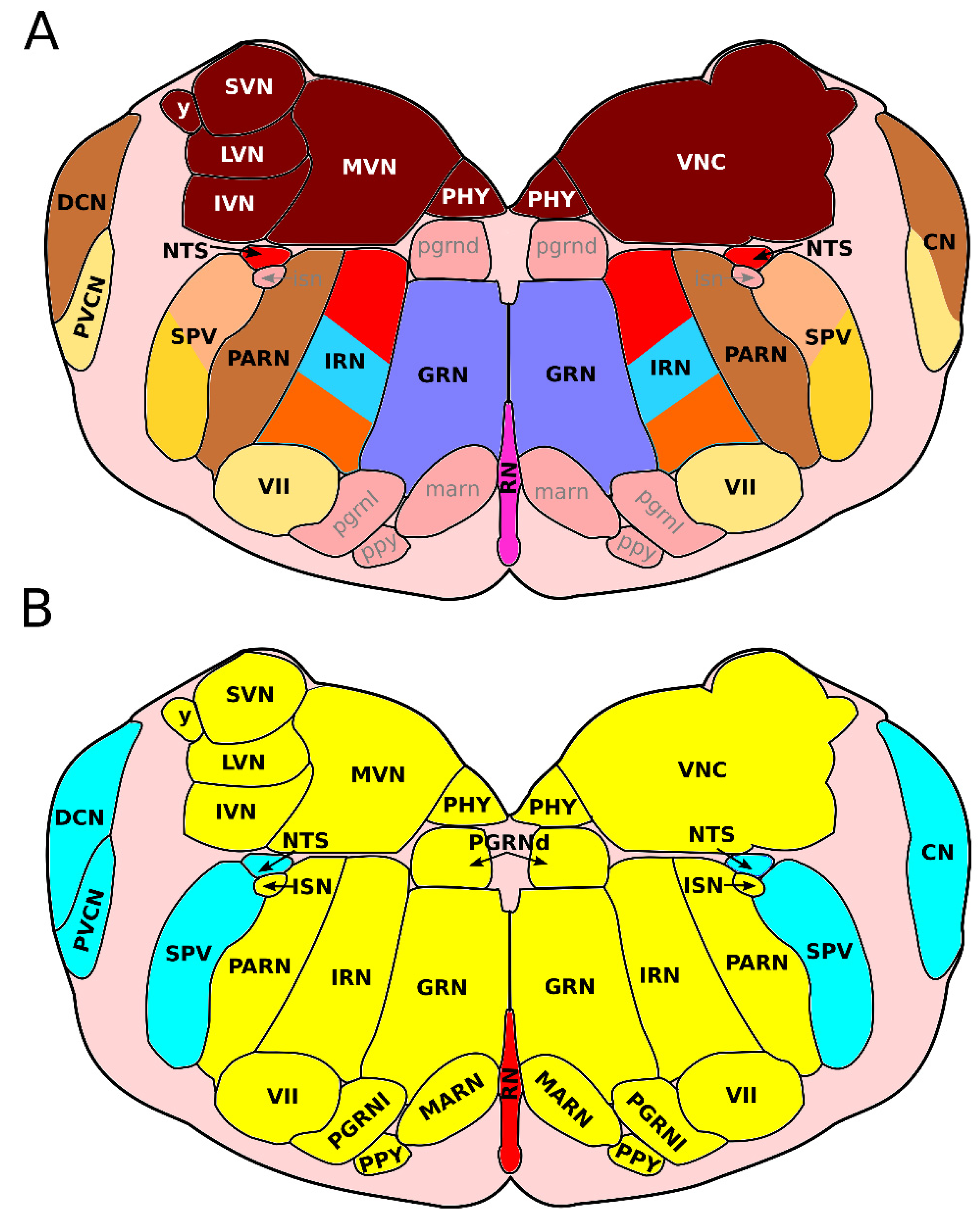
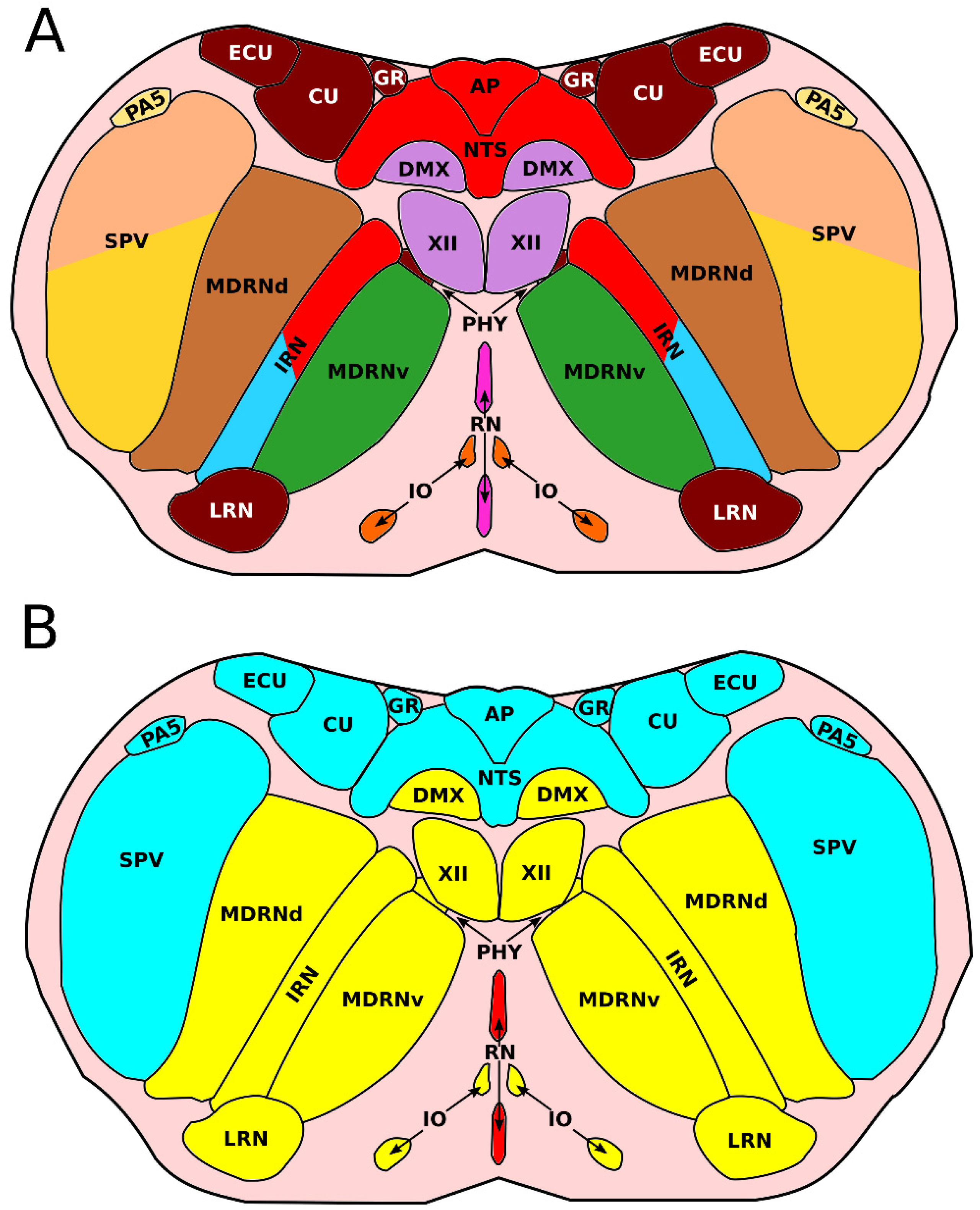
Publisher’s Note: MDPI stays neutral with regard to jurisdictional claims in published maps and institutional affiliations. |
© 2022 by the authors. Licensee MDPI, Basel, Switzerland. This article is an open access article distributed under the terms and conditions of the Creative Commons Attribution (CC BY) license (https://creativecommons.org/licenses/by/4.0/).
Share and Cite
Diek, D.; Smidt, M.P.; Mesman, S. Molecular Organization and Patterning of the Medulla Oblongata in Health and Disease. Int. J. Mol. Sci. 2022, 23, 9260. https://doi.org/10.3390/ijms23169260
Diek D, Smidt MP, Mesman S. Molecular Organization and Patterning of the Medulla Oblongata in Health and Disease. International Journal of Molecular Sciences. 2022; 23(16):9260. https://doi.org/10.3390/ijms23169260
Chicago/Turabian StyleDiek, Dina, Marten Piet Smidt, and Simone Mesman. 2022. "Molecular Organization and Patterning of the Medulla Oblongata in Health and Disease" International Journal of Molecular Sciences 23, no. 16: 9260. https://doi.org/10.3390/ijms23169260
APA StyleDiek, D., Smidt, M. P., & Mesman, S. (2022). Molecular Organization and Patterning of the Medulla Oblongata in Health and Disease. International Journal of Molecular Sciences, 23(16), 9260. https://doi.org/10.3390/ijms23169260






